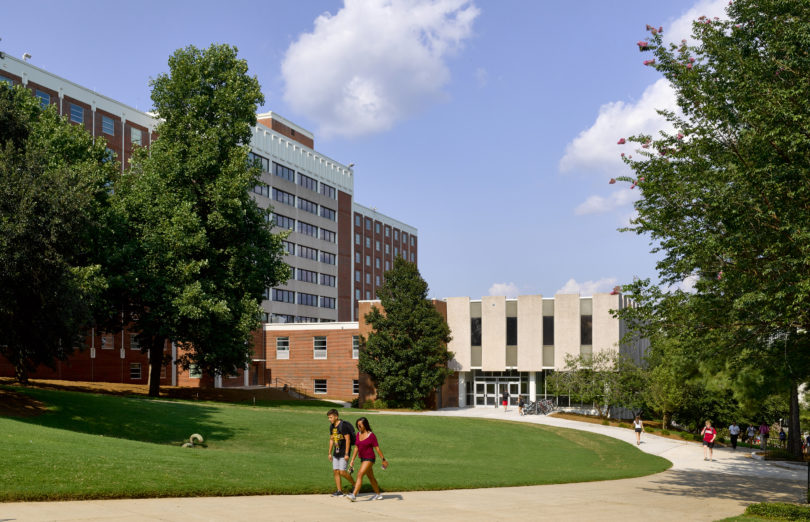Two University of Georgia projects recently won preservation awards from the Athens-Clarke Heritage Foundation. The university’s Historic Preservation Master Plan was named Outstanding Achievement, and the renovations at the Russell Hall residence hall earned Outstanding Rehabilitation honors.
The Outstanding Achievement award recognizes exemplary activities in the field of historic preservation. UGA submitted its plan to document and maintain UGA buildings 50 years old and older on all campuses and across the state. The plan was launched by President Jere W. Morehead, who charged a steering committee chaired by Dan Nadenicek, former dean of the College of Environment and Design. Scott Messer, director of historic preservation in the Office of University Architects for Facilities Planning, provided support to the steering committee and managed the overall development of the plan.
“The Historic Preservation Master Plan is an innovative and powerful tool that integrates historic preservation and archaeology into the early facilities planning stages. Receiving this award is a tribute to the quality and future impact of this wide-reaching plan,” said Gwynne Darden, associate vice president for facilities planning. “I’m proud of everyone who was involved and am grateful to the Athens-Clarke Heritage Foundation for its recognition and shared dedication to historic preservation.”
The process started in 2014 with a student-driven historic resource inventory with oversight from CED faculty and consultant teams. Nine graduate assistantships and a number of internships were established in the college’s Master of Historic Preservation Program to create the inventory. With help from the FindIT Program in CED’s Center for Community Design and Preservation, experiential learning opportunities were established.
Those students traveled across the state to document each historic UGA building and cultural landscape and created an inventory of the more than 730 buildings and 55 landscapes. This information was studied and enhanced by the consultant team led by Wiss, Janney, Elstner Associates Inc. serving as external consultant. The new electronic database inventory includes a history, context, significance, condition and integrity of each historic building. Now that the inventory is in place, the university can follow the detailed process on upkeep of all historic buildings.
“It is very gratifying that the efforts of our students,
faculty and staff were recognized for significant contributions to an award-winning plan,” said Sonia Hirt, current dean of the College of Environment and Design and Hughes Professor in Landscape Architecture and Planning.
The Outstanding Rehabilitation award honors excellence in the wholesale rehabilitation of a structure, defined as the act of returning a dilapidated, neglected and/or damaged property to a state of utility through repair or alteration. The projects give the structures an efficient, contemporary use while preserving those portions or features that are significant to its historical, architectural and cultural integrity.
University Housing’s Russell Hall, which is the residence to about a thousand students, went through a 15-month renovation and reopened in August 2018. The project also won an award earlier this year for Excellence in Sustainable Preservation from the Georgia Trust for Historic Preservation. In addition, the project earned “Two Peaches” from the Georgia Peach Green Building Certification, recognizing building systems efficiency gains as well as the inclusion of 10% Georgia-based materials, and the Construction Management Association of America Project Achievement Award in the category of Public Building Renovation, constructed value less than $50 million.
The updated rooms include individual, modernized temperature control and flexible room furnishings, and there is increased bathroom privacy and lounge spaces to encourage group interaction.
At more than 230,000 square feet, Russell Hall is the largest comprehensive historic building renovation at the University of Georgia and serves as a model of sustainable historic preservation. All of the worn building systems were replaced with new, modern, efficient ones, new high-performance windows were installed, the roof was replaced and various exterior repairs were performed including reworking brick sills and lintels—horizontal supports across the top of a door or window.
The building’s renovated interior preserves a unique mid-century aesthetic, such as the original terrazzo floors in the lobby.
Juneau Construction served as the construction manager for the project. Menefee Architecture, with CannonDesign, designed the project, and Wiss, Janney, Elstner Associates Inc. served as the Historic Preservation Master Plan consultant.
“More than 60,000 UGA students have lived in Russell Hall since it was built in 1967,” said Linda Kasper, executive director of University Housing. “The decision to renovate Russell Hall honors our history and ensures future generations of Bulldogs continue to start their UGA experience calling Russell Hall home.”








